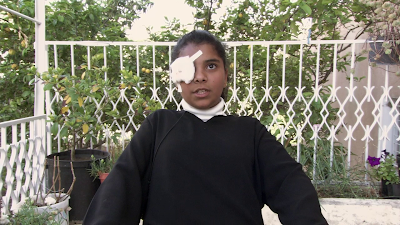

When the actors are pulled from the same environment as that which is being depicted, there is a sense of memory retrieval in their performance. What is gained is an
idea: it's the idea of a heightened authenticity; in appearance, tone, and gesture; – this gain is supported by the participant's approval of what is being depicted, and in their attempt to physically match what previously occurred. A similar technique is used in the films of Paul Greengrass, – much of the Haditha massacre reminded me of his 'Blood Sunday' (2002), released only five years previously. How does this differ from a professionally dramatized production? The form the acting takes is certainly affected: mumbly, conversational, camera-aware, familiar; spontaneous moments occur as if distilled by the deliberate arrangement of wild elements, but once subsided, the narrative continues along with a feeling of separation from non-fictional reality similar to that of the professionally staged. Each individual photographed carries a strong sense of empathy with the scenario they find themselves in: even reprehensible extremes of action become perceived as something at work in a larger field of behaviour, something bred not of the individual's demeanor, but as a manifestation of society, of zeitgeist, as something the spectator could never understand unless standing where the character stood at that exact moment in time. This technique of '
direct cinema' makes visible the invisible subtleties existing within a group (by presenting realities unimaginable unless resulted from true jeopardy) – and if used on both sides of a binary, of the Self and of the Other (the United States marines // the Iraqi insurgents), all of the performers will be blanketed with this curiosity and openness for empathy. It is, then, back in the structural narrative of the film where ideology represents itself.


 When the actors are pulled from the same environment as that which is being depicted, there is a sense of memory retrieval in their performance. What is gained is an idea: it's the idea of a heightened authenticity; in appearance, tone, and gesture; – this gain is supported by the participant's approval of what is being depicted, and in their attempt to physically match what previously occurred. A similar technique is used in the films of Paul Greengrass, – much of the Haditha massacre reminded me of his 'Blood Sunday' (2002), released only five years previously. How does this differ from a professionally dramatized production? The form the acting takes is certainly affected: mumbly, conversational, camera-aware, familiar; spontaneous moments occur as if distilled by the deliberate arrangement of wild elements, but once subsided, the narrative continues along with a feeling of separation from non-fictional reality similar to that of the professionally staged. Each individual photographed carries a strong sense of empathy with the scenario they find themselves in: even reprehensible extremes of action become perceived as something at work in a larger field of behaviour, something bred not of the individual's demeanor, but as a manifestation of society, of zeitgeist, as something the spectator could never understand unless standing where the character stood at that exact moment in time. This technique of 'direct cinema' makes visible the invisible subtleties existing within a group (by presenting realities unimaginable unless resulted from true jeopardy) – and if used on both sides of a binary, of the Self and of the Other (the United States marines // the Iraqi insurgents), all of the performers will be blanketed with this curiosity and openness for empathy. It is, then, back in the structural narrative of the film where ideology represents itself.
When the actors are pulled from the same environment as that which is being depicted, there is a sense of memory retrieval in their performance. What is gained is an idea: it's the idea of a heightened authenticity; in appearance, tone, and gesture; – this gain is supported by the participant's approval of what is being depicted, and in their attempt to physically match what previously occurred. A similar technique is used in the films of Paul Greengrass, – much of the Haditha massacre reminded me of his 'Blood Sunday' (2002), released only five years previously. How does this differ from a professionally dramatized production? The form the acting takes is certainly affected: mumbly, conversational, camera-aware, familiar; spontaneous moments occur as if distilled by the deliberate arrangement of wild elements, but once subsided, the narrative continues along with a feeling of separation from non-fictional reality similar to that of the professionally staged. Each individual photographed carries a strong sense of empathy with the scenario they find themselves in: even reprehensible extremes of action become perceived as something at work in a larger field of behaviour, something bred not of the individual's demeanor, but as a manifestation of society, of zeitgeist, as something the spectator could never understand unless standing where the character stood at that exact moment in time. This technique of 'direct cinema' makes visible the invisible subtleties existing within a group (by presenting realities unimaginable unless resulted from true jeopardy) – and if used on both sides of a binary, of the Self and of the Other (the United States marines // the Iraqi insurgents), all of the performers will be blanketed with this curiosity and openness for empathy. It is, then, back in the structural narrative of the film where ideology represents itself.
No comments:
Post a Comment